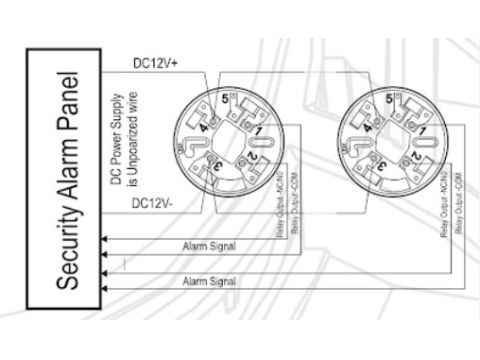In fire alarm systems, heat detectors identify a potential fire by monitoring significant temperature changes. They come in two primary categories:
- Maximum (Fixed-Temperature)
- Activates at a specified temperature threshold.
- Rate-of-Rise (Differential)
- Monitors how quickly the temperature climbs, triggering an alarm if it exceeds a certain rate.
The most versatile devices, maximum-rate (combination) detectors, integrate both principles. Below, we outline how to properly install and wire heat detectors, highlighting their recommended uses, limitations, and the relevant code requirements.
Types of Heat Detectors
Maximum (Fixed-Temperature) Detectors
- Trigger when the ambient temperature reaches a preset limit (e.g., 135–160°F / 57–71°C).
- Ideal for areas where temperatures don’t fluctuate rapidly.
- Common in dusty or harsh environments where smoke detectors could cause false alarms.
Rate-of-Rise (Differential) Detectors
- Activate if the temperature rises faster than a certain threshold (e.g., 12–15°F per minute).
- Catch fast-developing fires more quickly than fixed detectors alone.
- May be less effective if slow, smoldering fires occur without a swift temperature spike.
Combination (Maximum-Rate)
- Incorporate both fixed and differential functions, ensuring better overall coverage.
- More accurate at detecting both rapid and slow temperature increases.
Spot (Point) vs. Linear
Point Detectors:
- Mounted on ceilings or high walls; each sensor covers a specific area (e.g., up to 400–900 sq. ft. depending on ceiling height and local regulations).
- Most commonly used in standard building environments.
Linear Detectors:
- Often a “heat-sensing cable” that changes resistance or triggers a short when the temperature along its length reaches a limit.
- More expensive and specialized—useful for tunnels, cable trays, or areas where long, narrow coverage is necessary.
Installation Best Practices
Code & Standards
In the United States, installation must conform to NFPA 72 (National Fire Alarm and Signaling Code) or local fire codes. Elsewhere, national standards such as BS 5839 (UK) or SP 5.13130.2009 (CIS region) may apply. These documents outline:
- Minimum Number of Detectors per Room
- Allowed Coverage per Detector (based on ceiling height)
- Maximum Distances between detectors and from walls
- Special Cases like overhead beams, high storage racks, or non-typical room shapes
Note: Installing a fire alarm system typically requires licensed professionals who are familiar with these standards and have the authority to issue compliance certificates.
Placement
- Ceiling Mount:
- The most common approach, ensuring the detector “sees” hot air rising.
- Wall Mount (Exceptions):
- Some codes allow wall mounting if the ceiling is too high or the detector must be placed within 8 inches (200 mm) of the ceiling (for up to ~20-foot/6 m ceiling heights).
- Must still follow code rules for spacing and distance from corners or beams.
Environmental Considerations
Heat detectors are suited to places where smoke detectors may not work well—e.g., dusty, steamy, or smoky environments. However:
- Slow Heat Loss: Airflow may cool the detector area, delaying activation.
- Rapid Cooling: Intense ventilation could also mislead a rate-of-rise detector.
- Regular Testing: As with all fire devices, regular functional checks and proper documentation are mandatory.
Wiring & Integration
Heat detectors generally fall into wired categories, although some manufacturers also offer wireless addressable models. Common wiring schemes include:
Two-Wire (Conventional/Non-Addressable)
- Often referred to as a “smoke/heat circuit” or “zone wiring.”
- Detectors draw power from the zone circuit. When triggered, they alter the current consumption or switch contacts.
Four-Wire
- Separate pairs for power and the alarm relay.
- Less common in modern fire systems but still used in certain legacy or hybrid systems.
Addressable Heat Detectors
- Communicate with the fire alarm control panel (FACP) via a digital protocol.
- Each device has a unique ID, enabling pinpoint identification of which device triggered an alarm.
- Polarity usually matters—always check the manufacturer’s wiring diagram.
Maximum vs. Addressable
Conventional (Threshold) Heat Detectors:
- Affordable but less informative.
- Each zone may contain multiple detectors, so the control panel only knows which zone triggered, not specifically which detector.
Addressable Detectors:
- More expensive but allow more precise alarm location and advanced diagnostics.
- Offer better scalability for complex buildings.
DIY vs. Professional Installation
While property owners might attempt to install residential fire alarms (including heat detectors) in non-regulated environments (e.g., single-family homes or rural cabins):
- Code Knowledge:
- Proper placement requires familiarity with fire codes; improper spacing can lead to missed fires or nuisance alarms.
- Licensing:
- Commercial or multi-dwelling installations typically require a licensed fire system installer.
- Inspections by authorities (AHJs) can fail if the system isn’t installed by certified professionals.
Conclusion
Heat detectors are an indispensable part of many fire alarm systems, especially in environments unsuitable for smoke detectors due to dust, steam, or cooking fumes. By monitoring temperature levels, maximum (fixed-temperature) detectors address steadily growing fires, while rate-of-rise (differential) detectors respond to quick temperature jumps. Combination (max-rate) models provide added reliability and earlier fire recognition.
Key Points:
- Mounting: Generally on the ceiling, following local code for spacing and distance from walls or beams.
- Wiring: Often two-wire or addressable. Polarity and zone configurations differ by manufacturer.
- Usage: Ideal in high-dust areas or where smoke detection may cause false alarms.
- Code Compliance: Licensed installers and adherence to NFPA 72 (US) or local standards ensure a valid, safe installation.
For more guidance on selecting and installing heat detectors—or to find code-compliant fire alarm equipment—visit safsale.com. Our experts can help you design a reliable, standards-aligned fire alarm system that protects your property.

